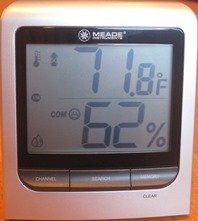Find a Mold Specialist Now
Click or Call, Toll-Free 24/7
What Is A Hygrometer?
What is a hygrometer? A hygrometer is simply a device that measures the relative humidity in the air. A portable hygrometer can be used in any room in your home. Some have multiple sensors so you can monitor the humidity in several areas of your home with only one hygrometer.
If you are asking about a hygrometer, it’s probably because you are concerned about the humidity in your home. Many people are concerned about toxic mold in the home these days, and mold is much more likely to grow in homes with high humidity. Some people also get concerned about the low levels of humidity in the wintertime, because that can cause very dry skin and chapped lips, which can become quite uncomfortable.
How Does a Portable Hygrometer Work?
There are a couple different types of portable hygrometers. One type of portable hygrometer contains two thermometers, one with a wet bulb and one with a dry bulb. As water from the wet bulb evaporates, the temperature drops. By comparing the difference in temperature between the two thermometers, the relative humidity in an area is determined.
Another type of portable hygrometer actually uses a human hair to determine the level of relative humidity in an area. You may have noticed that some people tend to have “bad hair days” when the weather is particularly humid. That’s because human hair expands and contracts based on the amount of humidity in the air. Hygrometers that use human hairs to measure the relative humidity in an area use a needle gauge to determine just how much the hair expands or contracts and use that information to determine the relative humidity in the area.
What Is a Hygrometer Used For?
Now you know how a portable hygrometer works, but what is a hygrometer used for? Why should you care about the relative humidity in your home? It may surprise you, but excessive humidity can lead to all sorts of problems. It may surprise you even more to learn that insufficient humidity can also cause problems.
Here are just a few of the issues associated with high humidity in the home:
- The air feels stuffy and uncomfortable.
- Your skin may feel clammy.
- There is an unpleasant musty smell.
- You may have a problem with mildew in your bathroom.
- Mold may grow in particularly damp areas, like the basement and bathroom.
- Mold growth in the home can lead to numerous health problems, especially respiratory problems.
- Mold can also ruin carpet and furnishings.
And here are just a few of the issues associated with low humidity in the home:
- Your skin may get dry, sometimes so dry that you develop painful cracks in the skin, especially on areas like your hands and feet.
- Your lips can also become very chapped, sometimes so chapped that they crack and bleed.
- Paint on your walls or on furniture may crack and peel.
- Wooden furniture and musical instruments like pianos, guitars and violins may grow warped; musical instruments can be ruined over time.
So if both high and low levels of humidity can cause all these problems, what is a hygrometer reading supposed to be at? Ideally, the humidity in your home should be between 30 and 50 percent to avoid problems.
The Best Hygrometer For Home Use
We’ve checked out a number of hygrometers and found one that we can really recommend from Ambient Weather. It measures temperature as well as relative humidity, is extremely accurate and simple to use. Click on the link to learn more about our Top Rated Hygrometer from Ambient Weather. The link will take you to Amazon where you can read reviews from other customers.
Return From What Is A Hygrometer To Our Best Hygrometer Page
Black Mold Health Symptoms Home Page





